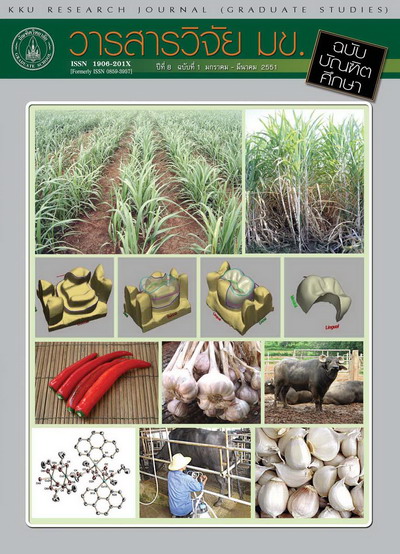The Activity of M/Ce-Sm-O Mixed Oxide (M = Pt, Pd and Re) for Water Gas Shift Reaction(การศึกษาประสิทธิภาพในการเร่งปฏิกิริยาของตัวเร่งปฏิกิริยา M/Ce-Sm-O (M=Pt, Pd และ Re) สำหรับปฏิกิริยา water gas shift)
Keywords:
Water gas shift reaction( ปฏิกิริยา water gas shift ), Samarium(ซัมมาเรียม), Temperature-programmed reduction(อุณหภูมิรีดักชัน)Abstract
The influence of samarium on the water gas shift activities of noble metal Pt, Pd and Re on ceria was studied. Ceria supports were modified by doping Sm at various weight percents. The flow reactor was used to study the activity of the catalysts in temperature range 150-600 °C. The feed gas composition was 5%CO, 10%H2O and balance He, and the total flow rate was 100 mL/min. The %CO conversion was analyzed by on-line gas chromatography with TCD detector. Modification of ceria with samarium significantly improved the activity of the Pd and Re catalysts. The activities of Re/Ce-Sm-O and Pd/Ce-Sm-O were greatly enhanced when compared with the activities of Re/CeO2 and Pd/CeO2, respectively. The activity of Pt/Ce-Sm-O remained the same with that of Pt/CeO2. By varying wt. % of Sm loading, it was found that the maximum catalytic activity was achieved at 1 wt. % for Pd/Ce-Sm-O and 10 wt. % for Re/Ce-Sm-O.
The catalysts were characterized by X-ray diffraction, Raman spectroscopy, Temperature-Programmed reduction and surface area analysis. XRD pattern indicated that Sm3+ incorporated into subsurface region of CeO2 lattice to form solid solution, gave rise to unit cell enlargement and increased specific surface area. The structural distortions inside ceria lattice produced strain into the oxide lattice and facilitated oxygen vacancies formation. The H2-TPR profiles of Re/Ce-Sm-O and Pd/Ce-Sm-O exhibited lowering of reduction temperature of surface oxygen which explained the activity enhancement of these catalysts. For Pt catalyst which possessed the highest activity, Pt played an important role in catalyzing the surface reduction of ceria and addition of Sm did not alter the reduction temperature of surface ceria. Thus, doping ceria with Sm did not improve the WGS activity of Pt catalyst.
ได้ศึกษาอิทธิพลของซัมมาเรียมที่มีต่อประสิทธิภาพในการเร่งปฏิกิริยา WGS ของโลหะ Pt Pd และ Re บนตัวพยุงซีเรียที่เติมซัมมาเรียมที่มีปริมาณต่างๆ กัน โดยศึกษาประสิทธิภาพในการเร่งปฏิกิริยาในช่วงอุณหภูมิ 150 – 600 oC แก๊สที่ใช้เป็นสารตั้งต้นสำหรับปฏิกิริยา WGS ประกอบด้วยคาร์บอนมอนอกไซด์ 5 % ไอน้ำ 10 % และก๊าซฮีเลียม โดยมีอัตราการไหลทั้งหมดเป็น 100 mL/min ได้มีการวิเคราะห์เปอร์เซ็นต์การเปลี่ยนแปลงคาร์บอนมอนอกไซด์โดยใช้ gas chromatography ที่มี TCD เป็นตัวตรวจวัด การปรับแต่งซีเรียด้วยซัมมาเรียมสามารถพัฒนาประสิทธิภาพในการเร่ง
เมื่อเทียบกับ Re/CeO2 และ Pd/CeO2 ตามลำดับ แต่ประสิทธิภาพในการเร่งปฏิกิริยาของ Pt/Ce-Sm-O ยังคงเหมือนกับ Pt/CeO2 ได้มีการปรับเปลี่ยนปริมาณของซัมมาเรียม เพื่อหาประสิทธิภาพในการเร่งปฏิกิริยาสูงสุด พบว่าประสิทธิภาพในการเร่งปฏิกิริยาสูงสุดคือ 1% Sm โดยมวลและ 10% Sm โดยมวล สำหรับ Pd/Ce-Sm-O และ Re/Ce-Sm-O ตามลำดับ
ได้ศึกษาลักษณะทางกายภาพและทางเคมีของตัวเร่งปฏิกิริยาโดยใช้เทคนิคการเลี้ยวเบนของรังสีเอ็กซ์ สเปกโทรสโกปีรามาน อุณหภูมิรีดักชันและการวิเคราะห์พื้นผิว สเปกตราของการเลี้ยวเบนของรังสีเอ็กซ์แสดงให้เห็นว่าซัมมาเรียมแทรกเข้าไปภายในโครงผลึกของซีเรีย ทำให้หน่วยเซลล์ขยายขนาดใหญ่ขึ้น และมีพื้นที่ผิวเพิ่มขึ้น โครงสร้างที่ผิดปกติภายในโครงผลึกซีเรียทำให้เกิดช่องว่างของออกซิเจน ผลการศึกษาจาก H2-TPR ของ Re/Ce-Sm-O และ Pd/Ce-Sm-O แสดงการลดลงของอุณหภูมิรีดักชันของสารเร่งปฏิกิริยา ซึ่งลดความเสถียรของผลึก และผลึกจะถูกรีดิวซ์ได้ง่ายขึ้น สำหรับ Pt ซึ่งตามปกติมีประสิทธิภาพในการเร่งปฏิกิริยาสูงอยู่แล้ว การเติมซัมมาเรียมลงบนซีเรียไม่ทำให้การเร่งปฏิกิริยา WGS ของ Pt ดีขึ้น เนื่องจาก Pt มีอันตรกิริยากับซีเรีย ทำให้ซีเรียถูกรีดิวซ์ได้ง่ายอยู่แล้ว การเติม Sm ลงบนซีเรียจึงไม่มีอิทธิพลเพิ่มขึ้นในการรีดิวซ์ซีเรีย



